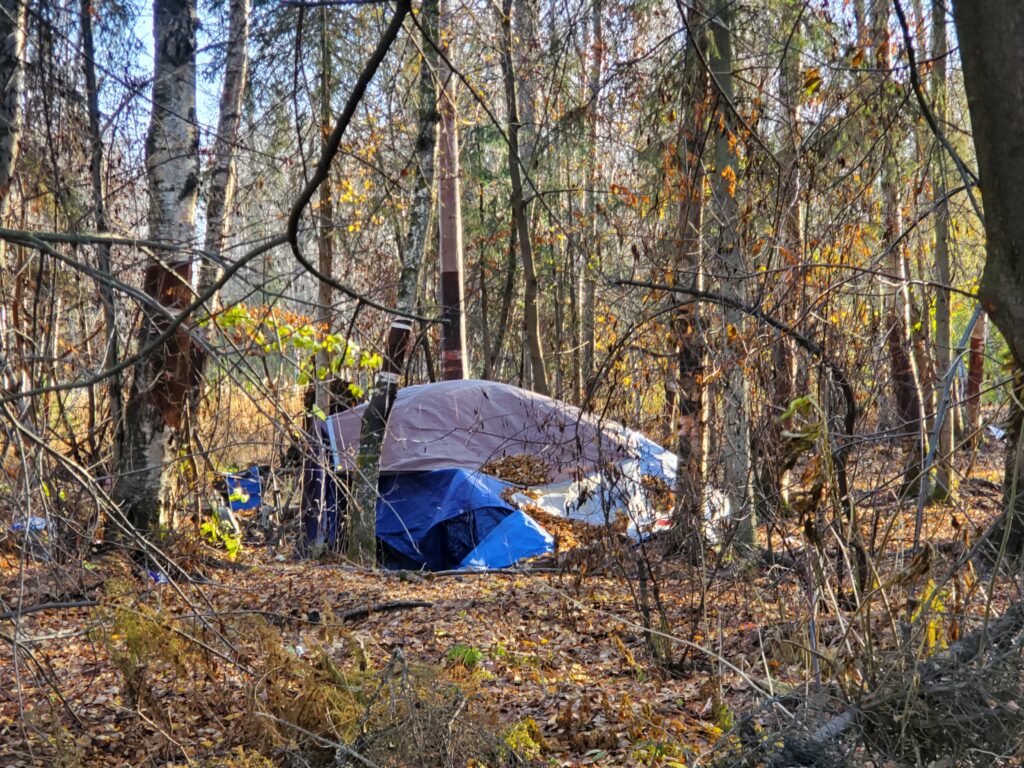A campsite is seen on Oct. 18 in the woods along the Campbell Creek Trail in Midtown Anchorage. Unsheltered people face a much higher risk of cold-exposure injuries than do housed people, state data shows. But the rate of such injuries among the homeless is not clear because the homeless population is difficult to define and identify. (Photo by Yereth Rosen/Alaska Beacon)
Unhoused people accounted for nearly a quarter of the Alaskans who were hospitalized with cold-related injuries like frostbite and hypothermia from 2012 to 2021, according to a report released by the state Division of Public Health.
Data from the Alaska Trauma Registry showed that being unhoused was identified as the main underlying factor in 23.3% of cold-exposure injuries, and the odds of such injuries among people without housing were about eight times those with housing. The results were summarized in a bulletin published by the division’s epidemiology section.
The results probably underestimate the problem of cold exposure among the homeless, said Riley Fitting, a state epidemiologist who compiled the report.
The numbers reflect the hospital patients who disclosed their housing situation, Fitting said, and patients may not have done so.
“We know that we might have undercounted the number of people without housing in these data,” he said.
Additionally, the numbers do not show how many Alaskans are unhoused, making it impossible to use this information to calculate a full population risk, he said.
There were some “exceptionally harsh winters” when cold-exposure injuries spiked – but only for the patients without housing, he said. For Alaskans with housing, the trend line was fairly flat throughout the study period, despite the severe winters of 2012, 2020 and 2021.
About three-quarters of the unhoused injured people whose hospital cases were recorded by the Alaska Trauma Registry were in Anchorage, Fitting said.
That tracks with the overall unhoused population in Alaska, which tilts more heavily to Anchorage, he said.
Anchorage is home to about 40% of the state population, but the city, the state’s largest, has a disproportionately high percentage of the state’s unhoused residents.
Other parts of Alaska have more severe climates and other conditions that create higher vulnerability to cold-exposure injuries. Northern Alaska and Western Alaska rank much higher on what is termed the “Extremely Cold Social Vulnerability Index,” a calculation of environmental conditions and socioeconomic conditions like income, housing availability and public services, according to a study co-authored by experts at the University of Alaska Fairbanks’ International Arctic Research Center.
Still, Anchorage conditions – even if they are not at ultra-low Arctic levels – pose plenty of risks to those without housing, Fitting said.
“It’s still very cold when you’re living outside,” he said. “There are frostbites year-round.”
Cold-exposure injuries and deaths have long been of concern in Alaska, where many people spend extended periods outdoors working, recreating or gathering wild foods.
Past studies of such injuries show mixed trends.
One study, from the 1990s, found that about half of the frostbite injuries among Alaska-based U.S. Army soldiers occurred during field training, and that most cold-exposure injuries happened when the wind-chill factor was at or below minus-20 degrees Fahrenheit.
In commercial fishing, where participants face risks of cold-water immersion, fatalities have been on the decline over several years, and well-maintained safety equipment has been shown to protect those who do fall into cold waters, according to a 2018 study by experts at the National Institute for Occupational Safety and Health.
However, there has been an increase in cold-weather drownings in climates that are warming, including Alaska, a trend attributed to weaker river and lake ice, according to a 2020 study.
GET THE MORNING HEADLINES.

